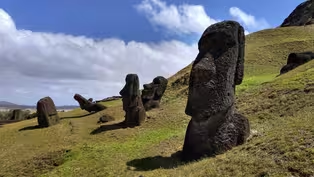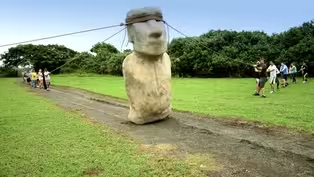
What really led to the collapse of Easter Island?
Clip: Season 51 Episode 2 | 2m 58sVideo has Closed Captions
What happened to the Rapa Nui civilization is shrouded in mystery.
There are multiple theories about what happened to the people of Rapa Nui - also known as Easter Island - and the famous Moai statues. Some say the civilization fell into collapse and ruin. But a new theory tells a different story, one of resilience and ingenuity against all odds.
Problems playing video? | Closed Captioning Feedback
Problems playing video? | Closed Captioning Feedback
National Corporate funding for NOVA is provided by Carlisle Companies and Viking Cruises. Major funding for NOVA is provided by the NOVA Science Trust, the Corporation for Public Broadcasting, and PBS viewers.

What really led to the collapse of Easter Island?
Clip: Season 51 Episode 2 | 2m 58sVideo has Closed Captions
There are multiple theories about what happened to the people of Rapa Nui - also known as Easter Island - and the famous Moai statues. Some say the civilization fell into collapse and ruin. But a new theory tells a different story, one of resilience and ingenuity against all odds.
Problems playing video? | Closed Captioning Feedback
How to Watch NOVA
NOVA is available to stream on pbs.org and the free PBS App, available on iPhone, Apple TV, Android TV, Android smartphones, Amazon Fire TV, Amazon Fire Tablet, Roku, Samsung Smart TV, and Vizio.
Buy Now

NOVA Labs
NOVA Labs is a free digital platform that engages teens and lifelong learners in games and interactives that foster authentic scientific exploration. Participants take part in real-world investigations by visualizing, analyzing, and playing with the same data that scientists use.Providing Support for PBS.org
Learn Moreabout PBS online sponsorship- [Narrator] Rapa Nui, also known as Easter Island.
This tiny little island in the South Pacific is world-famous for one thing, the moai.
- The moai building has often been portrayed as some kind of frenzy, as some kind of competition between different clan groups where lots of trees were cut down in order to construct and to transport the moai.
- [Narrator] According to this view, moai building deforested the island.
The soil was starved of nutrients, leaving a barren rock-strewn land.
Then, this theory goes, things got worse.
- The scarcity of resources resulted in a societal collapse.
The island erupted into intertribal warfare and led to a very impoverished population living on a barren island.
- [Narrator] The true story of Rapa Nui is one of survival against the odds by an ingenious and resilient people who came to a bad land and made it good.
Looking at all the archeological evidence, it seems more likely that rather than a self-inflicted ecocide, the true collapse of Rapa Nui society was caused by outside influences.
- As time went on and the evidence accumulated, we realized that a lot of what people thought was collapse was something that actually happened after Europeans arrived and it had an entirely different cause, and that was the introduction of Old World disease.
- There was the smallpox, there was the Spanish flu, leprosy, slave trading.
It was difficult to live here, and it was more difficult to keep the social structures and the life as the way that we knew it.
- [Interviewee] Over time, we see people sort of abandoning ahu and moai.
It's a loss of population.
There're just fewer people because of the effects of diseases.
So people are not attending to the ahu and rebuilding them in the way that they did in the past.
- [Narrator] Things got even worse in the 1860s.
- Peruvian slave traders captured about a third of the population on the island and forced them onto their ships to work in Peru.
(interviewee speaking in French) - [Interpreter] There were protests, even the Vatican got involved, and consequently, the companies were forced to return the inhabitants to the islands.
However, these people had contracted smallpox on the American continent.
Only 15 people made it home, and this was enough for an epidemic of smallpox to break out there.
(interviewee speaking in French) - [Narrator] By the time it was over, there were less than 200 Rapa Nui left alive.
(suspenseful music)
Video has Closed Captions
Preview: S51 Ep2 | 30s | Surprising new evidence is rewriting the story of the giant stone heads of Easter Island. (30s)
How Ancient Easter Island statues “walked”
Video has Closed Captions
Clip: S51 Ep2 | 2m 17s | These giant stone heads were not dragged on sleds, as once thought. (2m 17s)
Providing Support for PBS.org
Learn Moreabout PBS online sponsorship
- Science and Nature

Capturing the splendor of the natural world, from the African plains to the Antarctic ice.













Support for PBS provided by:
National Corporate funding for NOVA is provided by Carlisle Companies and Viking Cruises. Major funding for NOVA is provided by the NOVA Science Trust, the Corporation for Public Broadcasting, and PBS viewers.




